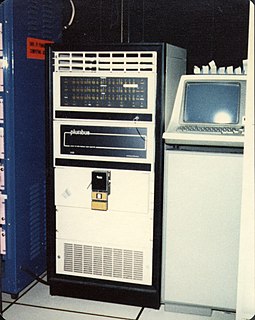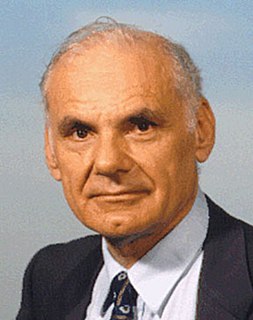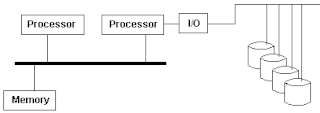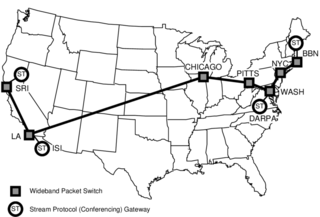Related Research Articles

A router is a networking device that forwards data packets between computer networks. Routers perform the traffic directing functions on the Internet. Data sent through the internet, such as a web page or email, is in the form of data packets. A packet is typically forwarded from one router to another router through the networks that constitute an internetwork until it reaches its destination node.

In computing, a process is the instance of a computer program that is being executed by one or many threads. There are many different process models, some of which are light weight, but almost all processes are rooted in an operating system (OS) process which comprises the program code, assigned system resources, physical and logical access permissions, and data structures to initiate, control and coordinate execution activity. Depending on the OS, a process may be made up of multiple threads of execution that execute instructions concurrently.

Symmetric multiprocessing or shared-memory multiprocessing (SMP) involves a multiprocessor computer hardware and software architecture where two or more identical processors are connected to a single, shared main memory, have full access to all input and output devices, and are controlled by a single operating system instance that treats all processors equally, reserving none for special purposes. Most multiprocessor systems today use an SMP architecture. In the case of multi-core processors, the SMP architecture applies to the cores, treating them as separate processors.
Multiprocessing is the use of two or more central processing units (CPUs) within a single computer system. The term also refers to the ability of a system to support more than one processor or the ability to allocate tasks between them. There are many variations on this basic theme, and the definition of multiprocessing can vary with context, mostly as a function of how CPUs are defined.
The end-to-end principle is a design framework in computer networking. In networks designed according to this principle, guaranteeing certain application-specific features, such as reliability and security, requires that they reside in the communicating end nodes of the network. Intermediary nodes, such as gateways and routers, that exist to establish the network, may implement these to improve efficiency but cannot guarantee end-to-end correctness.

Raytheon BBN is an American research and development company, based next to Fresh Pond in Cambridge, Massachusetts, United States.

The Advanced Research Projects Agency Network (ARPANET) was the first wide-area packet-switched network with distributed control and one of the first networks to implement the TCP/IP protocol suite. Both technologies became the technical foundation of the Internet. The ARPANET was established by the Advanced Research Projects Agency (ARPA) of the United States Department of Defense.

Robert Elliot Kahn is an American electrical engineer, who, along with Vint Cerf, first proposed the Transmission Control Protocol (TCP) and the Internet Protocol (IP), the fundamental communication protocols at the heart of the Internet.

The Pluribus multiprocessor was an early multi-processor computer designed by BBN for use as a packet switch in the ARPANET. Its design later influenced the BBN Butterfly computer.

The Interface Message Processor (IMP) was the packet switching node used to interconnect participant networks to the ARPANET from the late 1960s to 1989. It was the first generation of gateways, which are known today as routers. An IMP was a ruggedized Honeywell DDP-516 minicomputer with special-purpose interfaces and software. In later years the IMPs were made from the non-ruggedized Honeywell 316 which could handle two-thirds of the communication traffic at approximately one-half the cost. An IMP requires the connection to a host computer via a special bit-serial interface, defined in BBN Report 1822. The IMP software and the ARPA network communications protocol running on the IMPs was discussed in RFC 1, the first of a series of standardization documents published by what later became the Internet Engineering Task Force (IETF).

The Network Voice Protocol (NVP) was a pioneering computer network protocol for transporting human speech over packetized communications networks. It was an early example of Voice over Internet Protocol technology.

Lawrence Gilman Roberts was an American engineer who received the Draper Prize in 2001 "for the development of the Internet", and the Principe de Asturias Award in 2002.
The Voice Funnel was an experimental high-speed interface between digitized speech streams and a packet switching communications network, in particular the ARPANET. It was built in the time frame from 1979 to 1981. It may be viewed as an early Voice over IP voice and video telephone.

A multi-core processor is a microprocessor on a single integrated circuit with two or more separate processing units, called cores, each of which reads and executes program instructions. The instructions are ordinary CPU instructions but the single processor can run instructions on separate cores at the same time, increasing overall speed for programs that support multithreading or other parallel computing techniques. Manufacturers typically integrate the cores onto a single integrated circuit die or onto multiple dies in a single chip package. The microprocessors currently used in almost all personal computers are multi-core.
SIMNET was a wide area network with vehicle simulators and displays for real-time distributed combat simulation: tanks, helicopters and airplanes in a virtual battlefield. SIMNET was developed for and used by the United States military. SIMNET development began in the mid-1980s, was fielded starting in 1987, and was used for training until successor programs came online well into the 1990s.

Sun-1 was the first generation of UNIX computer workstations and servers produced by Sun Microsystems, launched in May 1982. These were based on a CPU board designed by Andy Bechtolsheim while he was a graduate student at Stanford University and funded by DARPA. The Sun-1 systems ran SunOS 0.9, a port of UniSoft's UniPlus V7 port of Seventh Edition UNIX to the Motorola 68000 microprocessor, with no window system. Early Sun-1 workstations and servers used the original Sun logo, a series of red "U"s laid out in a square, rather than the more familiar purple diamond shape used later.
The Worldwide Military Command and Control System, or WWMCCS, was a military command and control system implemented for the command and control of the United States military. It was created in the days following the Cuban Missile Crisis. WWMCCS was a complex of systems that encompassed the elements of warning, communications, data collection and processing, executive decision-making tools and supporting facilities. It was decommissioned in 1996 and replaced by the Global Command and Control System.

An asymmetric multiprocessing system is a multiprocessor computer system where not all of the multiple interconnected central processing units (CPUs) are treated equally. For example, a system might allow only one CPU to execute operating system code or might allow only one CPU to perform I/O operations. Other AMP systems might allow any CPU to execute operating system code and perform I/O operations, so that they were symmetric with regard to processor roles, but attached some or all peripherals to particular CPUs, so that they were asymmetric with respect to the peripheral attachment.

A butterfly network is a technique to link multiple computers into a high-speed network. This form of multistage interconnection network topology can be used to connect different nodes in a multiprocessor system. The interconnect network for a shared memory multiprocessor system must have low latency and high bandwidth unlike other network systems, like local area networks (LANs) or internet for three reasons:

The Terrestrial Wideband Network was a DARPA-sponsored experimental network designed to support research in high-speed networking protocols and distributed multimedia applications. It was built and operated by BBN Technologies from May 1989 to about 1991; although originally planned to turn into the Defense Research Internet, it instead evolved into the Defense Simulation Internet.
References
- ↑ Rettberg, R; Wyman, С; Hunt, D.; Hoffman, M.; Carvey, P.; Hyde, B.; Clark, W.; Kraley, M. (August 1979). "Development of a Voice Funnel". System: Design Report. Bolt Beranek and Newman Inc. Report No. 4098.
- ↑ Amestoy, Patrick R.; Daydé, Michel J.; Duff, Iain S.; Morère, Pierre (October 9, 1992), "Linear Algebra Calculations on a virtual shared memory computer", Int Journal of High Speed Computing (published 1992), vol. 7, pp. 21–43, CiteSeerX 10.1.1.37.8448
- ↑ Edmond, Winston; Blumenthal, Steven; Echenique, Andres; Storch, Steven; Calderwood, Tom; Rees, Tom (August 6, 1986), "The Butterfly Satellite IMP for the Wideband Packet Satellite Network", ACM SIGCOMM, Stowe, VT (published 1986), pp. 194–202
- ↑ Partridge, Craig; Blumenthal, Steven (January 2006). "Data Networking at BBN". IEEE Annals of the History of Computing. Washington, DC: IEEE Computer Society. 28 (1): 56–71. doi:10.1109/mahc.2006.7. S2CID 16881178.
- ↑ Leblanc, T. J.; Scott, M.L.; Brown, C.M. (September 1, 1988), Large-Scale Parallel Programming: Experience with the BBN Butterfly Parallel Processor, University of Rochester Computer Science Department, hdl:1802/15082